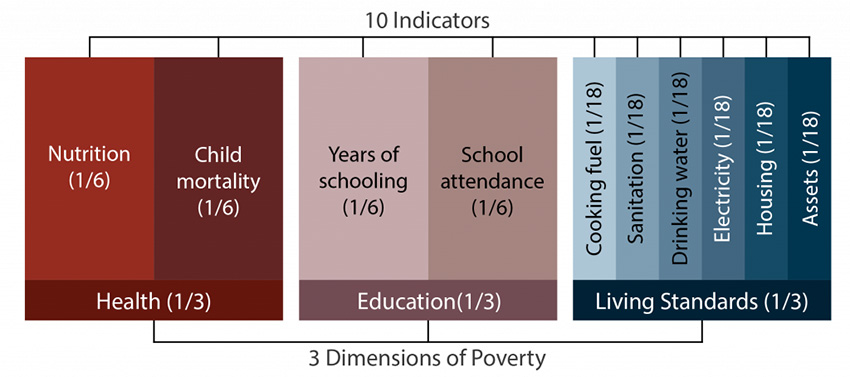Social Justice
Global Multidimensional Poverty Index 2021
- 11 Oct 2021
- 5 min read
Why in News
Recently, Global Multidimensional Poverty Index 2021 was released by the United Nations Development Programme (UNDP) and the Oxford Poverty & Human Development Initiative (OPHI).
- The Index considers data from 109 countries and 5.9 billion people.
Key Notes
- Global Data:
- 1.3 billion people are multidimensionally poor.
- About half (644 million) are children under age 18.
- Nearly 85% live in Sub-Saharan Africa (556 million) or South Asia (532 million).
- More than 67% live in middle-income countries.
- Periodic Reduction in Poverty:
- Of the 80 countries and five billion people for which there is data over time, 70 reduced MPI in at least one period, with the fastest changes coming from Sierra Leone (2013-2017), followed by Togo (2013/2014-2017).
- Absolute Reduction in Poverty:
- Some countries saw the fastest absolute reductions in their poorest regions-helping to fulfil their pledge to leave no one behind.
- These areas include North Central in Liberia (2013–2019/2020) and Province 2 in Nepal (2016–2019).
- Some countries saw the fastest absolute reductions in their poorest regions-helping to fulfil their pledge to leave no one behind.
- Poverty Across Ethnic and Racial groups:
- In some cases, disparities in multidimensional poverty across ethnic and racial groups are greater than disparities across geographical subnational regions.
- Within a country, multidimensional poverty among different ethnic groups can vary immensely.
- Therefore different policy actions are needed to reduce multidimensional poverty.
- Education:
- Worldwide about two-thirds of multidimensionally poor people (836 million) live in households where no woman or girl completed at least six years of schooling.
- 227 million live in India.
- One-sixth of all multidimensionally poor people (215 million) live in households in which at least one boy or man has completed six or more years of schooling but no girl or woman has.
- The report also finds that women and girls living in multidimensional poverty are at higher risk of intimate partner violence.
- Worldwide about two-thirds of multidimensionally poor people (836 million) live in households where no woman or girl completed at least six years of schooling.
- Living Standard:
- 1 billion are exposed to solid cooking fuels, another billion live with inadequate sanitation and another billion have substandard housing.
- 788 million live in a household with at least one undernourished person.
- 568 million lack improved drinking water within a 30-minute round trip walk.
- Effect of Covid:
- The Covid-19 pandemic has eroded development progress around the world, and we are still grappling to understand its full impacts.
- It has exposed the weaknesses in social protections systems, education, and workers’ vulnerability around the world.
- These weaknesses are deepest in countries with higher levels of multidimensional poverty.
- Indian Scenario:
- As castes and tribes are a more prevalent line of social stratification in India, this index presents the incidence and intensity of multidimensional poverty among castes and tribes and among individuals who are not members of any caste or tribe.
- In India five out of six multidimensionally poor people are from lower tribes or castes.
- 9.4% of the Scheduled Tribe group lives in multidimensional poverty
- 33.3% of the Scheduled Caste group lives in multidimensional poverty.
- 27.2% of the Other Backward Class group lives in multidimensional poverty.
- In India close to 12% of the population live in female-headed households.
Multidimensional Poverty Index
- The Multidimensional Poverty Index was launched by the UNDP and the OPHI in 2010.
- MPI is based on the idea that poverty is not unidimensional (not just depends on income and one individual may lack several basic needs like education, health etc.), rather it is multidimensional.
- The index shows the proportion of poor people and the average number of deprivations each poor person experiences at the same time.
- MPI uses three dimensions and ten indicators which are:
- Education: Years of schooling and child enrollment (1/6 weightage each, total 2/6);
- Health: Child mortality and nutrition (1/6 weightage each, total 2/6);
- Standard of living: Electricity, flooring, drinking water, sanitation, cooking fuel and assets (1/18 weightage each, total 2/6).
- A person is multidimensionally poor if she/he is deprived in one third or more (means 33% or more) of the weighted indicators (out of the ten indicators). Those who are deprived in one half or more of the weighted indicators are considered living in extreme multidimensional poverty.
- MPI is significant as it recognizes poverty from different dimensions compared to the conventional methodology that measures poverty only from the income or monetary terms.







